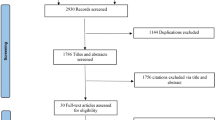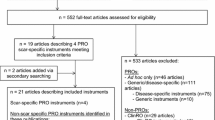Abstract
Post-surgical scarring impacts quality of life (QOL) and is a significant source of morbidity. Existing treatments targeted at improving the appearance and morbidity of scarring include laser-based therapies. Although lasers are frequently used to improve scar appearance, the effects on QOL are unclear. A scoping review was conducted to assess the impact of laser-based therapy for patients with surgical facial scarring on QOL. Throughout literature review was conducted with the guidance of a medical librarian. Relevant articles underwent two rounds of screening by two, independent reviewers. Data were extracted from each article and later analyzed. Of the four articles analyzed, laser-based therapies were demonstrated as effective in improving QOL for patients with facial scars resultant from surgical intervention. Laser-based therapy should be considered when treating facial scarring resultant from surgical intervention, as it has been shown to improve patient QOL. Standardization of QOL assessment and further studies expanding scar inclusion should be pursued given the paucity of information found through this review.

Similar content being viewed by others
Change history
15 February 2024
A Correction to this paper has been published: https://doi.org/10.1007/s00403-024-02825-4
References
Tebble NJ, Adams R, Thomas DW, Price P (2006) Anxiety and self-consciousness in patients with facial lacerations one week and six months later. Br J Oral Maxillofac Surg 44:520–525
Brown BC, McKenna SP, Siddhi K, McGrouther DA, Bayat A (2008) The hidden cost of skin scars: quality of life after skin scarring. J Plast Reconstr Aesthet Surg 61:1049–1058
Lee Peng G, Kerolus JL (2019) Management of surgical scars. Fac Plast Surg Clin N Am 27:513–517
Alster TS (1994) Improvement of erythematous and hypertrophic scars by the 585-nm flashlamp-pumped pulsed dye laser. Ann Plast Surg 32:186–190
Kang BY, Ibrahim SA, Weil A, Reynolds KA, Johnson T, Wilson S et al (2022) Treatment of surgical scars with combination pulsed dye and fractional nonablative laser: a randomized controlled trial. Ann Surg 276:975–980
Karmisholt KE, Wenande E, Thaysen-Petersen D, Philipsen PA, Paasch U, Haedersdal M (2018) Early intervention with non-ablative fractional laser to improve cutaneous scarring—a randomized controlled trial on the impact of intervention time and fluence levels. Lasers Surg Med 50:28–36
Kwon SD, Kye YC (2000) Treatment of scars with a pulsed Er:YAG laser. J Cutan Laser Ther 2:27–31
Kim HS, Cho EJ, Park YM, Kim HO, Lee JY (2011) Punch excision combined with erbium:YAG fractional laser: its application on different types of scars in Asian patients (a pilot study). J Cosmet Laser Ther 13:196–199
Kim SG, Kim EY, Kim YJ, Lee SI (2012) The efficacy and safety of ablative fractional resurfacing using a 2,940-nm Er:yag laser for traumatic scars in the early posttraumatic period. Arch Plast Surg 39:232–237
Mansouri YAA, Szczecinska WA (2013) A severe case of Favré-Racouchot syndrome: an absolute indication for the full ablative superpulsed CO2 laser. J Am Acad Dermatol 68:AB223
Finlay AY, Khan GK (1994) Dermatology life quality index (DLQI)—a simple practical measure for routine clinical use. Clin Exp Dermatol 19:210–216
Meynköhn A, Fischer S, Neuss C, Willkomm LM, Kneser U, Kotsougiani-Fischer D (2021) Fractional ablative carbon dioxide laser treatment of facial scars: improvement of patients’ quality of life, scar quality, and cosmesis. J Cosmet Dermatol 20:2132–2140
Jenkinson C, Coulter A, Wright L (1993) Short form 36 (SF36) health survey questionnaire: normative data for adults of working age. BMJ 306:1437–1440
Lewis V, Finlay AY (2004) 10 years experience of the dermatology life quality index (DLQI). J Investig Dermatol Symp Proc 9:169–180
ACGME Program Requirements for Graduate Medical Education in Dermatology. Accreditation Council for Graduate Medical Education website2022.
Felce D, Perry J (1995) Quality of life: Its definition and measurement. Res Dev Disabil 16:51–74
Artzi O, Friedman O, Al-Niaimi F, Wolf Y, Mehrabi JN (2020) Mitigation of postsurgical scars using lasers: a review. Plast Reconstr Surg Glob Open 8:e2746
Dreher R, Blaya C, Tenório JL, Saltz R, Ely PB, Ferrão YA (2016) Quality of life and aesthetic plastic surgery: a systematic review and meta-analysis. Plast Reconstr Surg Glob Open 4:e862
Funding
None.
Author information
Authors and Affiliations
Contributions
JJ and MK were responsible for the screening and ultimate inclusion of articles. JJ was primarily responsible for the main manuscript text, with input from CR and MK, SK is a medical librarian who oversaw the project and worked within PRISMA. AS reviewed the manuscript and provided inclusion guidance. All authors reviewed the manuscript before submission.
Corresponding author
Ethics declarations
Conflict of interest
The authors declare no competing interests.
Additional information
Publisher's Note
Springer Nature remains neutral with regard to jurisdictional claims in published maps and institutional affiliations.
The original online version of this article was revised to correct the copyright holder and the affiliation details for author Amanda Suggs.
Rights and permissions
Springer Nature or its licensor (e.g. a society or other partner) holds exclusive rights to this article under a publishing agreement with the author(s) or other rightsholder(s); author self-archiving of the accepted manuscript version of this article is solely governed by the terms of such publishing agreement and applicable law.
About this article
Cite this article
Jacobs, J., Kattapuram, M., Rundle, C.W. et al. The impact on quality-of-life following treatment of surgical facial scars with laser-based therapy: a scoping review. Arch Dermatol Res 316, 47 (2024). https://doi.org/10.1007/s00403-023-02779-z
Received:
Revised:
Accepted:
Published:
DOI: https://doi.org/10.1007/s00403-023-02779-z




